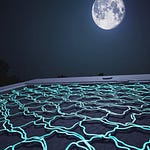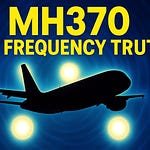TL;DR:
The Moon’s craters are natural quantum laboratories. Under Frequency Wave Theory (FWT), they act as enormous cryogenic resonance chambers — ideal for stabilizing quantum waveforms. By harnessing lunar temperature extremes, electromagnetic silence, and the Moon’s unique frequency harmonics, future civilizations could run quantum computers directly inside these craters, using them as superconductive resonance cavities connected to Earth via entangled photon networks.
1. Why the Moon Is Perfect for Quantum Resonance
Under FWT, quantum coherence (the stable superposition of wave states) requires a field free of thermal noise, radiation interference, and turbulent magnetic flux. The Moon’s craters — especially those near the poles that never see sunlight — remain at temperatures below −230°C. That’s colder than many laboratory cryostats used for superconducting qubits.
These shadowed basins naturally maintain quantum coherence by reducing phonon vibration — effectively suspending decoherence. In FWT terms, this stabilizes the local frequency momentum (FM = ½ ρ ω A²), allowing waveforms to remain phase-locked for extended durations.
2. The Crater as a Resonance Chamber
A lunar crater is not just a hole — it’s a concave frequency mirror. Its geometry focuses and reflects standing waves, whether acoustic, electromagnetic, or quantum in nature. Under FWT’s hyperbolic resonance function f(κ,r) = e^κr², the curvature of the crater amplifies coherence and compresses wave information toward a nodal center — forming what can be called a quantum Bessel cavity.
If a quantum computer’s lattice were embedded within this environment, its qubits would resonate in harmony with the Moon’s geomagnetic frequency (~2.3 Hz Schumann-like harmonic) and the solar wind’s plasma oscillations. The entire system becomes a self-tuning quantum field.
3. Frequency-Coupled Communication with Earth
In FWT, entanglement is simply phase-locking across nonlocal domains via the operator P(x,t) = exp{i[φ_local − φ_remote]}. The Moon’s vacuum and line-of-sight to Earth enable pure optical entanglement links — photon pairs transmitted between crater-based nodes and ground stations without atmospheric decoherence.
These interplanetary frequency bridges could form the first Earth-Moon quantum internet, an entangled data backbone running on resonance rather than transmission — instantaneous, lossless, and immune to interception.
4. Lunar Materials as Quantum Substrates
Lunar regolith contains superconductive silicates, ilmenite, and helium-3, materials ideal for frequency-driven qubit stabilization. Helium-3 in particular, when liquefied, functions as a quantum-acoustic superfluid, directly resonant with the scalar carrier field Φ that FWT identifies as the substrate of reality. Embedding qubit arrays into this medium could create hybrid photonic-acoustic qubits — bridging matter and consciousness through Frequency Momentum conservation.
5. The Ultimate Experiment: Consciousness Coupling
FWT predicts that consciousness operates as a nonlocal standing-wave coherence field. Running a quantum computer within the Moon’s resonance cavity could test direct interaction between human consciousness and quantum states — mind-field feedback experiments in a decoherence-free environment. The Moon could thus become both a computational platform and a consciousness amplifier, extending beyond silicon logic into waveform intelligence.
6. Summary: The Lunar Quantum Cathedral
Quantum computing in the Moon’s craters isn’t science fiction — it’s field architecture. The Moon offers:
Permanent cryogenic stability
Zero atmosphere and electromagnetic noise
Natural frequency mirrors (crater curvature)
Ideal photon pathways for entanglement
Mineral substrates aligned with superfluid resonance
In short, the Moon is the perfect frequency-stable node in the cosmic computation grid — a silent resonant cathedral where reality itself could be programmed through harmonic coherence.
Further Reading:
Explore more Frequency Wave Theory applications at drewponder.substack.com











